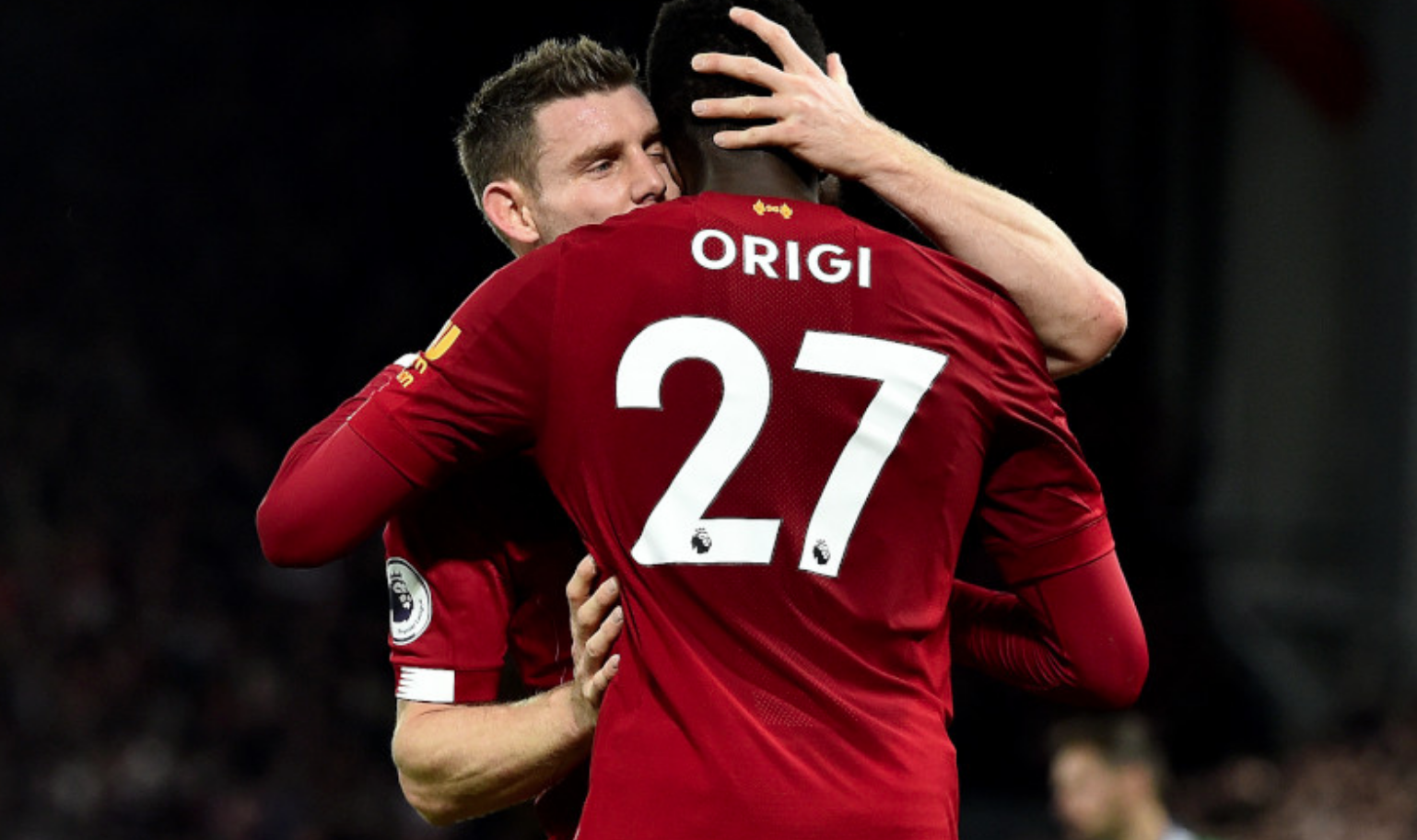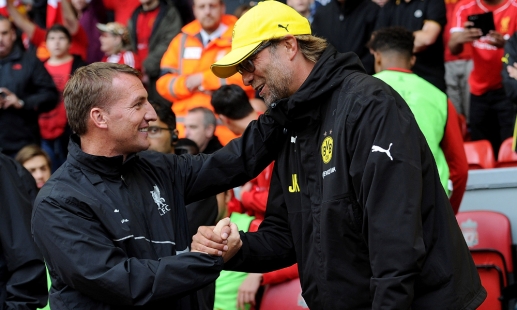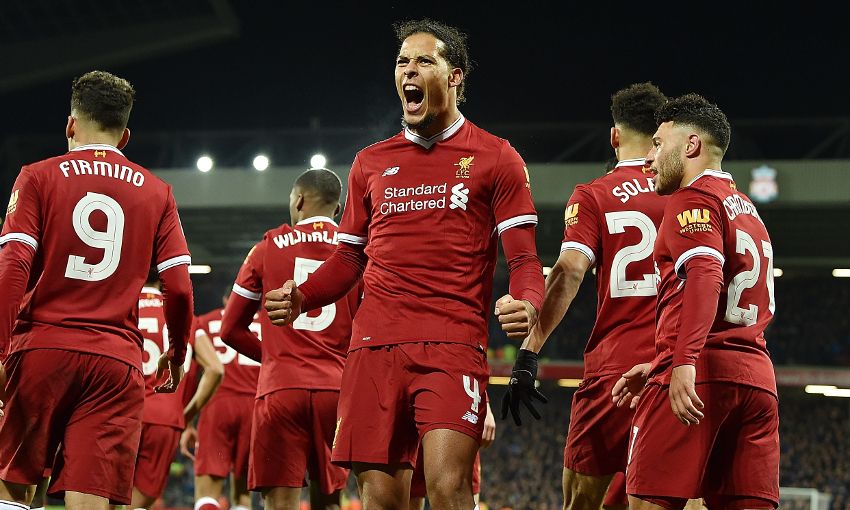As we approach the end of 2019, we are reaching not just the end of the calendar year, but also the dying embers of the decade. With this in mind, I thought I’d write a piece to summarise Liverpool’s decade. I’ve seen a lot of teams, moments and players of the decade-based stuff, so I’ve gone for something different.
The A to Z of Liverpool’s 2010s. For every single letter in the alphabet, I have picked something to do with Liverpool’s decade. Some were easier than others, and for most there were multiple options to pick from. This is the second part of this series, which will cover letters N-Z. If you missed the first part, which looked at A-M you can catch it here: http://fanscorners.com/z-liverpools-2010s-part-one/
Right then, here we go. 13 letters left!
N is for… Norbert
You thought I’d forgotten about him, didn’t you? Of course not – this section is dedicated to the man who turned Liverpool from mid-table fodder to the Champions of Europe and the best side in the world – Jurgen Norbert Klopp. It seems a formality that by the time Klopp leaves he will be the most popular manager in Liverpool’s history, and he’s certainly been the best boss in this decade. The German joined in October 2015 and there was an instant noticeable change in not only the playing style, but the belief and patience among fans. Kopites were prepared to write off defeats as stepping stones, with the knowledge that Klopp was starting to build a project and a team that he wanted, and that we could be proud of. Klopp’s astuteness in the transfer market is often praised but we must not forget the improvement he has overseen in players that were already at the club – the likes of Dejan Lovren and James Milner appeared to be going nowhere until Klopp came, while the German’s arrival heralded a new dawn for Roberto Firmino as a false nine, and he has never looked back. Under Klopp, Liverpool are now a feared opposition across Europe and are perennial contenders for the major honours, as well as currently holders of the titles of Champions of Europe, and the world. Any words from me would struggle to do justice to our manager’s achievements, so let’s use a quote from the great man himself from his first press at the club: ‘I am pretty confident we will have a title after four seasons’. Well, this is his fourth full season in charge…
O is for… Origi

Source: liverpoolfc.com
Divock Origi’s habit of scoring goals on the biggest of stages are fast propelling him to becoming a Liverpool icon. The Belgian was signed in 2014 from Lille and was immediately loaned back before making his debut in 2015. His first goals were a hat-trick in a Carabao Cup quarter-final at Southampton – how Origi is that? More big goals followed – a late equaliser against West Brom as well as strikes in the derby and in both legs against Dortmund, before a solid 2016/17 saw him score 11 times, including another Everton goal and a run of five scores in five. He spent the next season out on loan at Wolfsburg and looked to be out of the picture in 2018/19. That was, until, he came off the bench against Everton for his first appearance of the season and scored the craziest winning goal deep into stoppage time. This was the rebirth of his Liverpool career and he would go on to score a late winner in the penultimate game of the season, before famously scoring twice against Barcelona and then the clinching goal against Tottenham in the final. Even this season, his knack of delivering the huge moments has continued – one on opening night, another two in the derby, and a brace (including an injury time equaliser) to keep the Reds in the cup against Arsenal. A wonderful player and a hugely likeable character, Origi has 33 goals to his name in a Liverpool shirt, though my biggest question around him is still: why did he run to get the ball after scoring the late winner in the derby last season? What a guy.
P is for… Philippe
And now we move on to one of the best players Liverpool have had this decade: Philippe Coutinho. Signing as a curly-haired promising 20-year-old from Inter Milan for a modest fee of £8m, few could have predicted the impact the Brazilian would have on Liverpool in the five years that would follow. Coutinho was an instant success and became an integral part of both Brendan Rodgers’ and Jurgen Klopp’s teams. He scored some of Liverpool’s most beautiful goals this decade – the two winners against City, chipping David De Gea at Old Trafford, the stunning strike at Bolton, superb free-kicks against Leicester, Arsenal, Brighton and Middlesbrough all spring to mind. Goals in the derby, a late equaliser in the 2016 Carabao Cup final, a screamer on opening day at Stoke in 2015, long-distance efforts against Southampton, a goal in the famous Dortmund win and a hat-trick in a must-win Champions League tie at home to Spartak Moscow were all examples of Coutinho carrying the team and dragging Liverpool into favourable positions. Coutinho could score a goal from anywhere and was always a threat, even when as far as 35 yards from goal. His passing range and creativity, from the left wing or the midfield, just added to the 54 goals he scored in 201 games for Liverpool. A simply wonderful player to watch, and despite a drawn-out and uneasy exit in 2018, still a real contender for Liverpool’s player of the decade.
Q is for… Qatar
The most recent of Liverpool’s major successes in the 2010s was the Club World Cup victory, achieved in December 2019 in Qatar. As winners of the Champions League, Liverpool earned their right of passage straight into the semi-finals of the competition, where they took on the winners of North America’s Champions League, Monterrey. The Mexican side posed a far greater challenge than many expected, equalising just moments after Liverpool had taken a first-half lead through a beautifully worked Naby Keita goal. A delicious Trent Alexander-Arnold cross was finished by Roberto Firmino in injury time of the second half to send Liverpool to the final, where Firmino’s compatriots Flamengo lie in waiting. The Brazilians were out to repeat the success they had over the Reds in 1981 but Jurgen Klopp’s team had other ideas. A hard-fought 90 minutes ended goalless, though Liverpool had created the better chances. An opening was finally worked nine minutes into extra time. Jordan Henderson’s sumptuous through ball sent Sadio Mane free, and the Senegalese released the ball into Firmino. Poetically, it was the Brazilian forward who scored the game’s only goal, working the chance brilliantly before firing home. Liverpool held on courtesy of their other Brazilian on the field, Alisson, who was assured and highly reliable between the sticks. After 120 minutes in the Khalifa International Stadium in Doha, Liverpool were crowned champions of the world for the first time in their history, and at the fourth time of asking. An incredible way to see out the 2010s with Jurgen Klopp’s third trophy as Liverpool boss.
R is for… Rodgers

Source: liverpoolfc.com
The Northern Irishman became manager in June 2012 after taking Swansea to the Premier League and earning plaudits for the of play he implemented. Rodgers immediately set about developing a similarly attractive brand of football with the Reds. He brought Joe Allen with him from Swansea, who was solid, but his purchases of Fabio Borini and Nuri Sahin were badly unsuccessful. Midway through his first campaign he acquired Daniel Sturridge and Philippe Coutinho, who would go on to be crucial parts of his team the following season, jumping from 7th in his first year to a remarkable 2nd, after the most unlikely of title challenges, featuring some supreme attacking football, spearheaded by Luis Suarez, Raheem Sterling, Steven Gerrard, Jordan Henderson, Sturridge and Coutinho. Unfortunately for Rodgers, Sturridge missed most of 2014/15 through injury and Suarez was sold. The manager failed to replace him adequately, missing out on Alexis Sanchez and ending up with Mario Balotelli, Rickie Lambert and Lazar Markovic. A horrid season ensued, finishing 6th, the return to the Champions League ending in the group stages, and losing in both cup semi-finals. A poor start to 2015/16 saw him sacked in October after 166 games in charge. There was plenty to enjoy about Rodgers’ time – the football was exciting, and many of his signings have gone onto be important players for Jurgen Klopp – Coutinho, Sturridge, James Milner, Nathaniel Clyne, Alberto Moreno, Adam Lallana, Emre Can, Simon Mignolet, Joe Gomez, Roberto Firmino and Dejan Lovren. Since leaving, he has become one of the all-time great Celtic managers and is now spearheading a title challenge at Leicester – surely Liverpool can’t be stopped by their ex-manager?!
S is for… Southampton
Arguably the thing that has had the biggest influence on Liverpool’s decade! The Saints ended a seven-year exodus from the Premier League when they were promoted from the Championship in 2012, powered by the goals of Rickie Lambert and the creativity of Adam Lallana. Two years later, both had signed for Liverpool, alongside defender Dejan Lovren, who transferred after a brilliant first year on the South Coast. After signing three of their key players in the summer, the Reds were drawn to play Southampton in the first game of the forthcoming Premier League season by the totally-random-and-not-at-all-fixed-supercomputer. Lambert departed after a year, but Lallana and Lovren’s fortunes were turned around by Jurgen Klopp and remain important members of the squad five years down the line. The next three years saw a Southampton player signed in each of them – with an increasing degree of quality each time: Nathaniel Clyne in 2015, Sadio Mane In 2016 and Virgil Van Dijk in the winter of 2018. Another of Klopp’s big purchases has been Alex Oxlade-Chamberlain, who was a Saint before joining Arsenal! The roles have finally been reversed recently, with Danny Ings moving the other way in 2018. It’s not just players – Southampton were even managed by an ex-Liverpool player – Mauricio Pellegrino, from 2017 to 2018. The two clubs have shared some massive games this decade too – a Carabao Cup quarter-final that the Reds won 6-1 with a Divock Origi hat-trick, his first Liverpool goals, in 2015, was a highlight. Southampton got their revenge under Claude Puel though in 2017, eliminating Liverpool in the semis of the same competition, Shane Long scoring a late winner at Anfield to break Liverpool hearts.
T is for… Transfers
The first half of the decade saw a largely terrible return of signings, with the likes of Andy Carroll, Lazar Markovic, Paul Konchesky, Charlie Adam, Christian Poulsen, Stewart Downing, Alexander Doni, Samed Yesil, Nuri Sahin, Iago Aspas, Victor Moses, Brad Jones, Oussama Assaidi, Milan Jovanovic, Rickie Lambert and Mario Balotelli all complete and utter failures under messrs Hodgson, Dalglish and Rodgers. The only real successful signings from 2010-14 were Daniel Sturridge, Luis Suarez, Philippe Coutinho, Jordan Henderson, Simon Mignolet, Emre Can, Dejan Lovren, Adam Lallana, Kolo Toure, Divock Origi and Alberto Moreno – and eight of those didn’t get going until Jurgen Klopp arrived. The German’s appointment heralded a new dawn not only on the pitch but also in the transfer market. Since Klopp joined, star names like Sadio Mane, Mohamed Salah, Virgil Van Dijk, Naby Keita, Alex Oxlade-Chamberlain, Alisson Becker and Fabinho have been persuaded to move to Liverpool, while purchases like Andy Robertson, Roberto Firmino, Joel Matip, Georginio Wijnaldum, Joe Gomez, Xherdan Shaqiri and James Milner have turned into top-class players for the club under the tuition of Klopp. The German has been hugely a successful recruiter, with Loris Karius his only disappointing signing so far. Plenty of credit should be given to chief negotiator Michael Edwards, who has turned Liverpool into a shrewd and intelligent club in the market, who manage to attract great players for affordable prices and have an ability to sell their unwanted players for huge profits. Poetically, Edwards has ended this decade with a superb piece of business to come into play for the start of the next one – hot prospect Takumi Minamino for just £7.25m. This decade has also seen big departures – Fernando Torres at £50m, Suarez for £75m and Coutinho’s £142m sale are the three biggest of the last ten years.
U is for… Uruguayan
Luis Suarez is one of the most talented to ever pull on a red shirt. He was only on Merseyside for three and a half years but made an astronomical impact in that time, scoring 82 times, and cementing himself as one of the club’s best ever scorers of great goals. His arrival for £22.5m from Ajax in January 2011 will go down as a top-class piece of business, as Suarez developed from a talented but inconsistent player into a world-beating goal machine under Brendan Rodgers. His final two seasons saw him score 30 and 31, with many of those 31 sensational technical goals. The one that always springs to mind for me is the equaliser against a Newcastle in 2012 – terrifically controlling the ball on his shoulder, holding off Fabricio Coloccini, before rounding Tim Krul and slotting home. Still to this day the most magical goal I’ve ever seen. There are of course his 12 goals against Norwich (the Canaries were by far his favourite opponent) and a good number of those 12 were pearlers too. Other memorable goals included his one in the 2014 derby – robbing Everton of possession on the halfway line and racing clear to score, as well as his strike against Spurs a few months later, where he showed all the body strength in the world to shake off Michael Dawson before unleashing an unstoppable first-time strike past Hugo Lloris. Suarez was an incredible all-round player who carried the team in 2012/13 and made them brilliant in 2013/14. A controversial character who had some lows as well as highs at Liverpool, but my God, some player.
V is for… Van Dijk

Source: liverpoolfc.com
Ahh, the time has finally arrived for me to talk about Virgil Van Dijk. The now legendary Dutchman was first seriously looked at by Liverpool in the summer of 2018 and after a deal had been struck, it looked for all money that Van Dijk would leave Southampton and join the Reds. However, complications over the legalities of Liverpool’s approach meant that it fell through, leaving Jurgen Klopp with two choices: sign a different centre-back to bolster the area Van Dijk would’ve strengthened, or take a huge risk and do without until the next window, and then go again for Van Dijk. Fortunately, Klopp chose perfectly and Van Dijk became a Liverpool player in January 2018. The centre-back made an instant impact to the defence and was instrumental in Liverpool securing a top 4 place and making the Champions League final. It wasn’t until 2018/19 that we saw the best of him though. Van Dijk became the best and most important player in the team with his calm, commanding and unflappable displays leading Liverpool to a phenomenal title charge and Champions League win. Van Dijk’s sensational form led to him being crowned PFA Player of the Year, the first defender to win the accolade since 2005. He has continued to be a crucial part of the team this season and has cemented himself in most minds of Liverpool fans as the best defender we’ve all seen at the club. He is truly ridiculously good. Makes football look so easy. Another real contender for our player of the decade.
W is for… Werner
Nope, this section is not about RB Leipzig striker Timo Werner – though what a player he is! On 1st December 2010, the fabric of Liverpool’s structure changed significantly. Tom Werner became chairman after John W Henry’s Fenway Sports Group had acquired the purchase of the club six weeks earlier. The Americans immediately set about changing things at Liverpool. The first nine years of FSG’s reign have seen the club grow dramatically, in terms of both success and progress on the pitch, and its global reach, reputation and finances. FSG bought Liverpool for a cut price after a disastrous period of ownership from the two who shall not be named, but now the picture could not be more different – Liverpool are one of the most attractive, financially stable and marketable brands in the world. Werner and Henry are a major reason for that – their responsible ownership has propelled Liverpool into the situation they are in today, as European and World Champions. FSG have had questions thrown at them constantly throughout their tenure, but each time they have showed their care and love for the club and the fans (think of the ticketing structure change in 2016). Their constant backing of Jurgen Klopp as manager has helped facilitate Liverpool’s rise to glory, so we must thank the owners for that.
X is for… Xabi
One of the underplayed factors in Liverpool’s struggles at the start of the decade was the sale of Xabi Alonso in 2009 to Real Madrid. Alonso’s departure set the ball rolling for the next few years to be extremely challenging. Italian midfielder Alberto Aquilani was signed to replace Alonso, but the truth is that Aquilani would’ve struggled to cut it in League One that season – and that’s no disrespect to League One, really. Joe Allen had some similar attributes but was nowhere near as capable in any department as the Spaniard was. For years after Alonso left, central midfield was an issue. Steven Gerrard was slowing down, Lucas Leiva was excellent but provided no goal threat and suffered with two major injuries, Jordan Henderson didn’t really get going until 2013, Nuri Şahin had checked out before he’d even checked in, and then of course there was Charlie Adam. Alonso’s all-round presence in midfield was nigh-on impossible to replace. The passing game that he possessed, the vision and positional awareness, the knowledge and understanding of the game made him one of the best midfielders in the game at the time. We never replaced Alonso and always had a gaping hole in the squad – and it was always in that midfield area, lacking the quality that made Alonso so good. Since Jurgen Klopp has arrived, the midfield has changed massively, and Fabinho possesses plenty of Alonso’s key strengths, while Henderson’s raking passes are at times Alonso-esque. Alonso – and Javier Mascherano – were players who we only really saw how important they were once they had left. The departure of Xabi Alonso played a huge role in the first part of Liverpool’s decade.
Y is for… Youngsters
Liverpool’s decade hasn’t been blessed with youngsters making the step up into the first team and establishing themselves as regulars, though many have come into the side for spells before departing and making good careers elsewhere –Jordon Ibe, Martin Kelly and Conor Coady are all Premier League players now, while Ovie Ejaria and Ryan Kent are becoming tidy players at Reading and Rangers too. There have only really been two academy graduates who have made the grade for Liverpool: Raheem Sterling and Trent Alexander-Arnold. Sterling debuted in 2012 and it was clear that he was a real talent. A super breakout season in 2012/13, when he was at times carrying the team at 17, was followed with a move to a central role, where he was influential in Liverpool’s 2013/14 title charge. Too much pressure was placed on him in 2014/15 and he left for Man City, where he remains a key player today. Alexander-Arnold has gone from his debut in 2016 to being arguably the best right-back in the world a few years later, with a Champions League trophy and World Cup appearances under his belt. He is a crucial part in Jurgen Klopp’s side and despite being a defender, is integral to Liverpool’s attack, such is his wonderful ability to pass and cross a ball. A stunning player who is on his way to superstardom and will hopefully be here for many years – he certainly has the passion and love for the club. The 20-year-old should be an example to some of the current academy players with potential – Ki-Jana Hoever, Harvey Elliott, Herbie Kane and Curtis Jones, while Harry Wilson, Kamil Grabara and Marko Grujic could have roles too.
Z is for… Zidane
Although Liverpool lost the 2018 Champions League final to Zinedine Zidane’s Real Madrid – the third consecutive title for Los Blancos – the journey to get to that final should be remembered fondly, rather than the negatives of the unusual way in which the final was lost, courtesy of injury, horror mistakes and a classic goal. This was Liverpool’s first Champions League campaign under Jurgen Klopp and the first time the Reds had featured in the competition since 2014/15, so were relative newcomers to it. Klopp’s side finished top of a group with Sevilla, Maribor and Spartak Moscow, with three draws and three wins, including 7-0 triumphs in Slovenia and at home to Spartak. Sadio Mane scored a wonderful hat-trick in Portugal as the Reds smashed Porto 5-0 in the first leg of the round of 16, before facing the all-conquering Manchester City in the quarters. The first leg was at Anfield and Liverpool blew Pep Guardiola’s team away with three quick-fire goals, including a belter from Alex Oxlade-Chamberlain, before coming from a goal down to win 2-1 in the reverse leg at the Etihad, with goals from Mohamed Salah and Roberto Firmino to reach the semis for the first time since 2008. One of Anfield’s all-time great performances from Salah helped Liverpool to a 5-2 win against Roma in the first leg, and the Reds qualified for the final 7-6 on aggregate. Yes, the final against Zidane’s team in Kiev ended in defeat, but it was a truly remarkable run and was the rebirth of Liverpool’s relationship with its favourite competition – Liverpool were back in the Champions League final. And as we know from what happened a year later, the loss to Real Madrid was just the start…
And that brings to an end the second and final part of my A-Z of the decade. I hope you enjoyed it – it was certainly interesting taking a trip down memory lane to revisit some of the good and bad! Let’s hope that the 2020s carry on the way that the 2010s are ending.
Daniel Daykin
Latest posts by Daniel Daykin (see all)

Brilliant… really enjoyed this